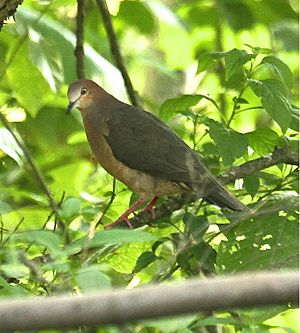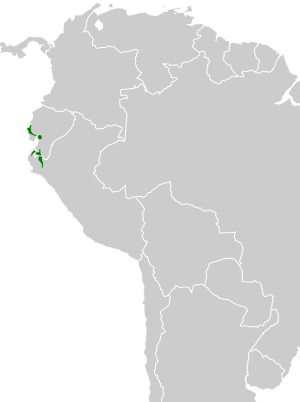Ochre-bellied dove facts for kids
Quick facts for kids Ochre-bellied dove |
|
|---|---|
 |
|
| Conservation status | |
| Scientific classification | |
| Genus: |
Leptotila
|
| Species: |
ochraceiventris
|
 |
|
The ochre-bellied dove (Leptotila ochraceiventris) is a special type of bird. It belongs to the dove and pigeon family, called Columbidae. You can find this beautiful bird living in the countries of Ecuador and Peru in South America.
Contents
About the Ochre-bellied Dove
What's in a Name?
The ochre-bellied dove is a unique bird. It is the only species in its specific group, which means it is monotypic. This dove is closely related to the grey-chested dove and the Tolima dove. They might even be part of a "superspecies" group. This means they are very similar and likely share a common ancestor.
How to Spot an Ochre-bellied Dove
This dove is about 23 to 25 centimeters (9 to 10 inches) long. It weighs around 146 grams (5 ounces). Its forehead is a light pinkish-white color. The top of its head is a rusty purple. The back of its neck shines with an iridescent purple.
The rest of its upper body is a dark olive-brown. It has a bronzy green or purple shimmer on its shoulders. Its inner tail feathers are dark brown. The outer tail feathers are black with white tips. Its throat is white, and its chest is reddish. The lower chest, sides, and belly are a buff color. It also has a bright yellow eye.
Where the Dove Lives
The ochre-bellied dove lives in two main areas. One is in the lowlands of western Ecuador. The other is in the lowlands and Andes mountains of southwestern Ecuador and northwestern Peru. These doves live in these areas all year round. However, they might move to different spots during certain seasons.
They like many types of places to live. These include moist evergreen forests and dry forests. They also live in lower mountain forests and humid cloud forests. You can usually find them between 500 and 1,800 meters (1,600 to 5,900 feet) high. Sometimes, they are found as low as 80 meters (260 feet) or as high as 2,625 meters (8,600 feet).
Dove Behavior and Life
What Do They Eat?
The ochre-bellied dove usually looks for food on the forest floor. They also search up to 4 meters (13 feet) above the ground. We don't know much about their full diet. But they have been seen eating fruit directly from trees. These doves are usually alone or in pairs. Sometimes, you might see them in groups of up to five. They gather with other doves at water holes to drink.
Reproduction and Nesting
We know very little about how the ochre-bellied dove raises its young. Scientists have observed them singing and looking ready to breed. It seems they might build nests and lay eggs between January and April. They may also breed again in August and September.
The Dove's Song
The ochre-bellied dove has a very special song. It is a single, slightly downward-sloping note. It sounds like "wOOOooo". The sound starts strong and clear, then slowly fades away.
Protecting the Ochre-bellied Dove
The IUCN (International Union for Conservation of Nature) keeps track of animals. They first thought the ochre-bellied dove was "Threatened." But since 1994, they have listed it as "Vulnerable." This means it is still at risk.
There are not many of these doves left. Their numbers are believed to be shrinking. This is mainly because their homes, the forests, are being lost. However, these doves can live in places where the habitat is not perfect. So, their population might not be declining as fast as once thought. Efforts are being made to protect their remaining habitats.
See also
 In Spanish: Paloma montaraz ventriocre para niños
In Spanish: Paloma montaraz ventriocre para niños


